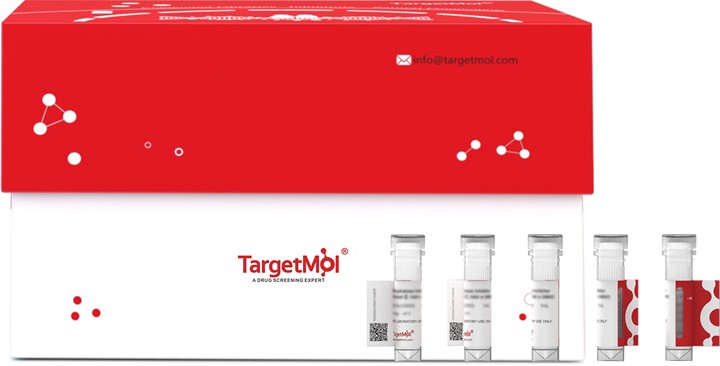 Your shopping cart is currently empty
Your shopping cart is currently empty
GSTK1 Protein, Human, Recombinant
Catalog No. TMPY-03450
GSTK1 gene encodes a member of the kappa class of the glutathione transferase superfamily of enzymes that function in cellular detoxification. Glutathione S-transferases (GSTs) are a family of enzymes that catalyze a variety of reactions in both eukaryotes and prokaryotes. They catalyze the conjugation of reduced glutathione with potentially toxic, xenobiotic substrates, thus aiding excretion from the body. GSTK1(glutathione S-transferase kappa 1) is localized to the peroxisome and catalyzes the conjugation of glutathione to a wide range of hydrophobic substates facilitating the removal of these compounds from cells. GSTK1 functions in cellular detoxification.

GSTK1 Protein, Human, Recombinant
Catalog No. TMPY-03450
GSTK1 gene encodes a member of the kappa class of the glutathione transferase superfamily of enzymes that function in cellular detoxification. Glutathione S-transferases (GSTs) are a family of enzymes that catalyze a variety of reactions in both eukaryotes and prokaryotes. They catalyze the conjugation of reduced glutathione with potentially toxic, xenobiotic substrates, thus aiding excretion from the body. GSTK1(glutathione S-transferase kappa 1) is localized to the peroxisome and catalyzes the conjugation of glutathione to a wide range of hydrophobic substates facilitating the removal of these compounds from cells. GSTK1 functions in cellular detoxification.
| Pack Size | Price | USA Warehouse | Global Warehouse | Quantity |
|---|---|---|---|---|
| 5 μg | $80 | 7-10 days | 7-10 days | |
| 10 μg | $128 | 7-10 days | 7-10 days | |
| 20 μg | $209 | 7-10 days | 7-10 days | |
| 50 μg | $416 | 7-10 days | 7-10 days | |
| 100 μg | $700 | - | In Stock |
Add to Cart
Add to Quotation
In Stock Estimated shipping dateUSA Warehouse [1-2 days] Global Warehouse [5-7 days]
All TargetMol products are for research purposes only and cannot be used for human consumption. We do not provide products or services to individuals. Please comply with the intended use and do not use TargetMol products for any other purpose.
Select Batch
Resource Download
Product Information
| Biological Activity | Activity testing is in progress. It is theoretically active, but we cannot guarantee it. If you require protein activity, we recommend choosing the eukaryotic expression version first. |
| Description | GSTK1 gene encodes a member of the kappa class of the glutathione transferase superfamily of enzymes that function in cellular detoxification. Glutathione S-transferases (GSTs) are a family of enzymes that catalyze a variety of reactions in both eukaryotes and prokaryotes. They catalyze the conjugation of reduced glutathione with potentially toxic, xenobiotic substrates, thus aiding excretion from the body. GSTK1(glutathione S-transferase kappa 1) is localized to the peroxisome and catalyzes the conjugation of glutathione to a wide range of hydrophobic substates facilitating the removal of these compounds from cells. GSTK1 functions in cellular detoxification. |
| Species | Human |
| Expression System | E. coli |
| Tag | Tag Free |
| Accession Number | Q9Y2Q3-1 |
| Synonyms | hGSTK1,GSTK1-1,GST13-13,GST13,GST,glutathione S-transferase κ1,glutathione S-transferase kappa 1 |
| Construction | A DNA sequence encoding the mature form of human GSTK1 (Q9Y2Q3-1) (Gly2-Leu226) was expressed with a N-terminal Met. Predicted N terminal: Met |
| Protein Purity | > 95 % as determined by SDS-PAGE |
| Molecular Weight | 25.5 kDa (predicted); 25 kDa (reducing conditions) |
| Endotoxin | Please contact us for more information. |
| Formulation | Lyophilized from a solution filtered through a 0.22 μm filter, containing 50 mM Tris, 10% glycerol, pH 8.0.Typically, a mixture containing 5% to 8% trehalose, mannitol, and 0.01% Tween 80 is incorporated as a protective agent before lyophilization. |
| Reconstitution | A Certificate of Analysis (CoA) containing reconstitution instructions is included with the products. Please refer to the CoA for detailed information. |
| Stability & Storage | It is recommended to store recombinant proteins at -20°C to -80°C for future use. Lyophilized powders can be stably stored for over 12 months, while liquid products can be stored for 6-12 months at -80°C. For reconstituted protein solutions, the solution can be stored at -20°C to -80°C for at least 3 months. Please avoid multiple freeze-thaw cycles and store products in aliquots. |
| Shipping | In general, Lyophilized powders are shipping with blue ice. |
| Research Background | GSTK1 gene encodes a member of the kappa class of the glutathione transferase superfamily of enzymes that function in cellular detoxification. Glutathione S-transferases (GSTs) are a family of enzymes that catalyze a variety of reactions in both eukaryotes and prokaryotes. They catalyze the conjugation of reduced glutathione with potentially toxic, xenobiotic substrates, thus aiding excretion from the body. GSTK1(glutathione S-transferase kappa 1) is localized to the peroxisome and catalyzes the conjugation of glutathione to a wide range of hydrophobic substates facilitating the removal of these compounds from cells. GSTK1 functions in cellular detoxification. |
Dose Conversion
You can also refer to dose conversion for different animals. More
Calculator
Tech Support
Please read the User Guide of Recombinant Proteins for more specific information.
Generate Quote
Catalog No.: Cas No.:
Add
| Size | Quantity | Unit Price | Amount | Operation |
|---|
Generate Quote

Copyright © 2015-2025 TargetMol Chemicals Inc. All Rights Reserved.



